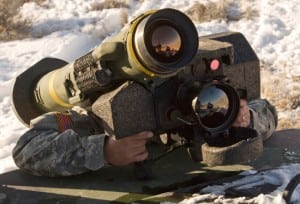The State Department approved a $39 million Foreign Military Sale (FMS) of 150 Javelin missiles to Ukraine and the top NATO commander said the country is ready for more.
The Defense Security Cooperation Agency (DSCA) said it notified Congress of the potential sale on Thursday.

Javelin is an anti-tank missile that can be carried and launched by a single soldier or from various platforms. It was developed and produced jointly for the U.S. Army and Marine Corps by a joint venture between Raytheon [RTN] and Lockheed Martin [LMT]. Javelins were first deployed in 1996 and the companies have produced tens of thousands of the missiles.
This FMS includes 150 Javelins plus 10 Javelin Command Launch Units, training devices, support equipment, personnel training, and other related U.S. government and contractor support services.
Raytheon [RTN] is the prime contractor for the Javelin.
DSCA said the proposed sale will help Ukraine “build its long-term defense capacity to defend its sovereignty and territorial integrity in order to meet its national defense requirements.”
Ukraine first requested these weapons earlier this past summer. In March 2018, the U.S. first approved providing Ukraine with 210 Javelin missiles and 37 launchers, which were delivered that year.
Ukraine has been seeking to increase its military capabilities since Russia annexed Crimea in 2014 and supported a separatist war in eastern Ukraine. Military aid to Ukraine has strong bipartisan support.
Relatedly, the NATO Supreme Allied Commander Europe and U.S. European Command Commander told reporters at an Oct. 3 Pentagon press briefing the Javelin is an important increase in capability for Ukraine’s military and the country is ready for more.
Air Force Gen. Tod Wolters contended that given the number of military training teams the U.S. and NATO have inserted into Ukraine, they are at the point where the partners are comfortable enough Ukrainian soldiers will have the capability to productively use any additional Javelins.
“I think we’re just about to the point to where we have hit the curve in the line that allows us the opportunity to say, yeah, I think more of those will probably help.”
Wolters went further, arguing “right now, it is my military advice that I think we should go forward with that because of the positive outcome, because they are better able to defend their sovereign territory.”
He also explained how the Javelin missile is a defensive contribution.
“It affords a soldier the opportunity to put a resource in his or her hands that affords them the opportunity to protect their sovereign turf. And it’s a sophisticated capability, it’s a modern capability, it has great precision, it has great speed,” Wolters said.

He characterized Ukraine as “very, very excited” about gaining the missiles.
Wolters noted the U.S. and NATO have been willing to go into Ukraine and “assist them with tactics, techniques and procedures to better utilize this resource to better defend their territory.”
Engagements to this effect over the 2019 summer “have been very, very productive.”
“All in all, when it’s said and done, you see a little bit of a bounce in the step of a Ukrainian soldier when he or she has had the opportunity to embrace this system that allows them to better defend their turf,” he continued.
DSCA said implementation of the sale will require additional contractor representatives to Ukraine, but no additional U.S. government personnel for an extended period of time.
This sale is separate from the continuing resolution approved last week that included $250 million to extend the Ukraine Security Assistance Initiative funds for one year when they were due to expire (Defense Daily, Sept. 26).
Pentagon spokesman Jonathan Hoffman told reporters in an wOct. 3 briefing that the Defense Department has so far provided $1.6 billion in military aide to Ukraine since 2014.
Javelin sales to Ukraine recently received significant attention in a July 25 phone call between President Trump and Ukraine President Volodymyr Zelenskiy that has now become the focus of a formal Democratic House impeachment inquiry (Defense Daily, Sept. 25).
The administration held up a previous installment of $250 million in authorized military aid until after the call. During the call Zelenskiy told Trump Ukraine was ready to buy more Javelins.
Last month, Senate appropriators said the White House unlocked the $250 million in military aide. The White House had previously claimed it was reviewing the aid package (Defense Daily, Sept. 13).